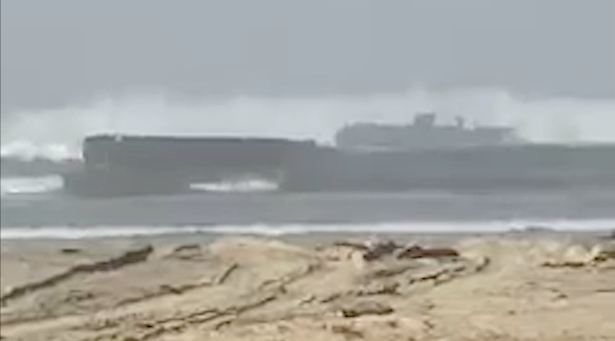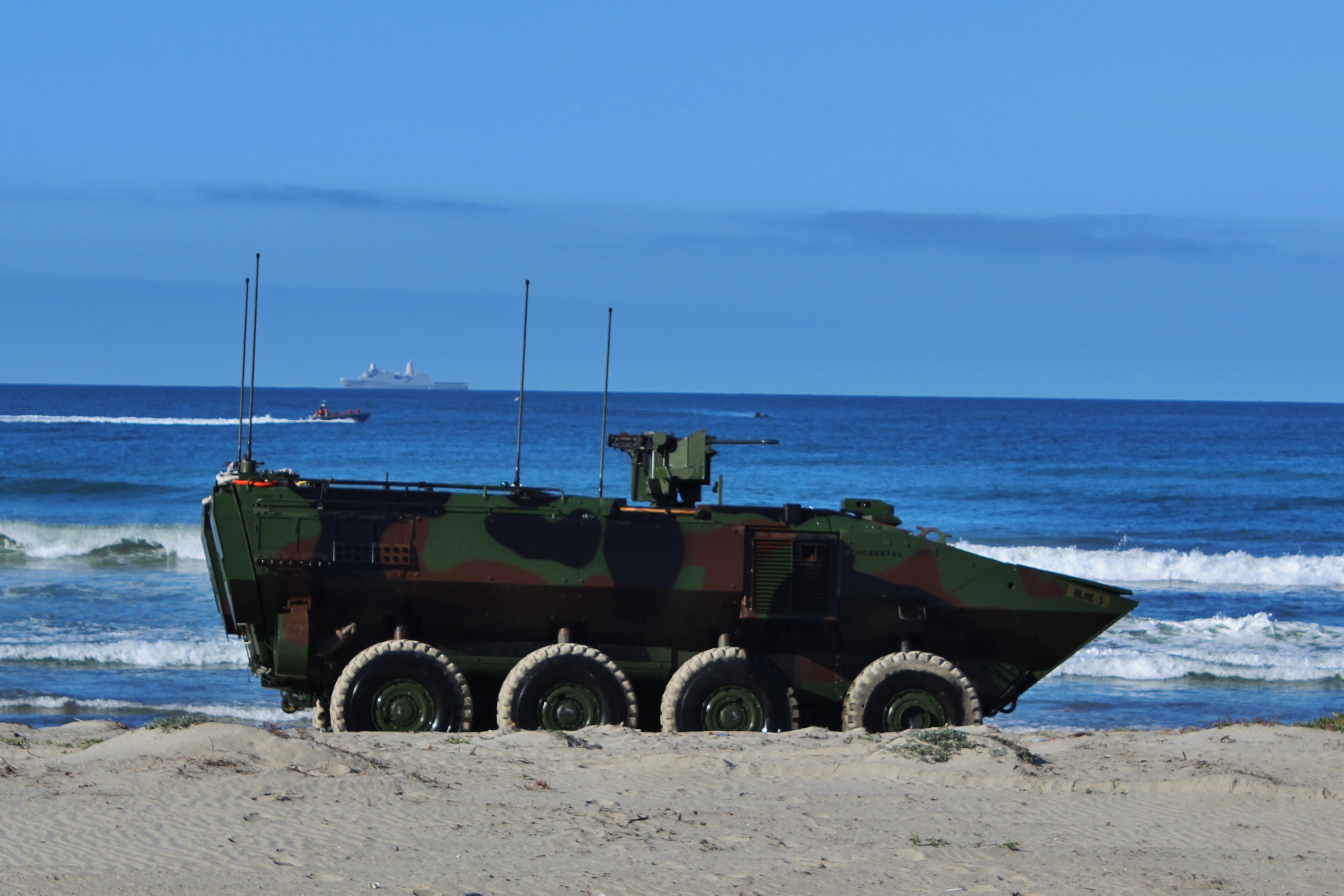
This post has been updated with a statement from the Marine Corps pausing waterborne operations as a result of the July 19 training incident.
The Marines are keeping their Amphibious Combat Vehicles out of the water following a Tuesday training incident in heavy surf that disabled two ACVs, the service announced late Wednesday.
“The pause of waterborne operations will allow for an investigation into the incident and ensure the assault amphibian community can review best practices and procedures to remain capable, safe, and ready,” reads the statement from the Marines.
The order from Lt. Gen. David Furness, the deputy commandant of the Marine Corps for plans, policies and operations, follows a Tuesday training incident in which a new ACV overturned in heavy surf as it approached a beach at Camp Pendleton, Calif., officials confirmed to USNI News on Wednesday.
No Marines were injured in the incident, which happened at about 8 a.m. local time during a training exercise at the southern California base, the Division said in a statement.
“One Amphibious Combat Vehicle (ACV) tipped onto its side in the surf zone and another ACV became disabled” during the training, according to the statement. “Marines in both ACVs conducted their immediate action drills and safely returned to shore. One vehicle was towed ashore and recovery efforts for the other vehicle are ongoing.”
The ACVs belong to 3rd Assault Amphibian Battalion, part of 1st Marine Division. It’s not clear which subordinate unit was involved in the incident. A request for additional information was pending with the division spokesman, 2nd Lt. Noah Richardson. The ACVs were not attached to the 13th Marine Expeditionary Unit, which is preparing to deploy later this year with the Makin Island Amphibious Ready Group, USNI News understands.
The National Weather Service had issued a high-surf advisory along the coast in San Diego and Orange counties, which would include Camp Pendleton’s beaches on its 16-mile shoreline along the Pacific, north of the coastal city of Oceanside. Eight-foot surf was reported in places that were ideal conditions for surfers but less so for anyone traversing the surf breaks, “with occasional sets of 9 to 10 feet,” according to the Tuesday morning advisory, which also noted strong rip currents. A tropical storm spinning southwest of the region and big southwest swells that began last week in the south Pacific have fueled big surf across the Pacific.
“We still have a high-surf advisory in effect … that’ll continue through tomorrow morning,” said NWS meteorologist James Brotherton in San Diego. “The biggest we’ve had is 10 feet at Oceanside.” The height of the waves breaking on shore “can vary from hour to hour,” Brotherton added.
The ACV crews encountered overhead waves Tuesday morning as the vehicles approached the wide, sandy beach and morning fog was pulling offshore, according to a video obtained by USNI News.
A pair of white safety boats were maneuvering inside the breaking surf where the ACVs were moving toward shore when one of the vehicles turns and is broadsided by a breaking wave. Several Marines can be seen jumping off the vehicle into the water and later floating in the white, churning foam, as another ACV is overturned in a shallower area nearby.
The incident comes almost two years after the fatal sinking of an amphibious assault vehicle, resulting in the deaths of eight Marines and a Navy corpsman. The AAV sunk while it was returning from San Clemente Island to amphibious transport dock USS Somerset (LPD-25). Investigations found a long line of failures and lack of adherence to safety procedures and standard operation procedures were responsible directly or in part for the deaths. These include the lack of water safety and egress training, inadequate safety gear, poorly done or lack of safety briefs, and no dedicated safety boat accompanying the vehicles during the waterborne operations.

Word of the incident and the conditions the ACV crews faced yesterday unnerved families still grieving the loss of their loved ones who died in the July 30, 2020, sinking of the AAV.
“You’ve lost nine service members basically less than two years ago. It is a huge thing that happened, and all these new sets of safety conditions have been put in place,” Peter Vienna, whose stepson, Navy Hospitalman Christopher Gnem, 22, died in the mishap. “You’d think at this point, they’d be super vigilant. To put them in the water, with that forecast, tell you, it still just was so incredibly a very poorly, risky to do shit like that when “The question becomes, what does it take to stop putting service members at risk?”
The 2020 incident also claimed the life of eight Marines: Cpls. Wesley A. Rodd, 23, of Harris, Texas, and Cesar A. Villanueva, 21, of Riverside, Calif.; Lance Cpls. Marco A. Barranco, 21, of Montebello, Calif., Guillermo S. Perez, 19, of New Braunfels, Texas, and Chase D. Sweetwood, 19, of Portland, Ore.; and Pfcs. Bryan J. Baltierra, 19, of Corona, Calif., Evan A. Bath, 19, of Oak Creek, Wisc., and Jack Ryan Ostrovsky, 21, of Bend, Ore.
“That’s really tough to witness because we’ve all had a mental picture in our heads for two years,” Vienna said of the video of Tuesday’s incident. “To see the actions that were done, and the guys got off and there’s safety boats in the water. It looked like they had been trained and got out, training our boys had never done.”
The rough surf conditions the ACV crews encountered at Camp Pendleton raises questions if the vehicles should have been in the water. The wheeled ACV, which the Marine Corps is fielding to replace the aging fleet of tracked AAVs, is designed to safely operate in waters up to sea state 3, similar to the amtrac. That would include pushing through breaking, small waves close to shore.
Higher sea state conditions were a similar concern families had about the 2020 AAV incident.
A senior officer had told investigators the sea state the AAV crews encountered that day was about 4-to-5 on the sea state scale, which would have put it far beyond the comfort level for safe amtrac operations, Vienna said.
“AAVs have a demonstrated ability to easily negotiate sea states one through three, but will experience difficulty maintaining speed and maneuverability in sea state four. AAVs can survive operations in sea state five, but at reduced effectiveness,” investigators wrote in a U.S. 3rd Fleet command investigation, dated June 4, 2021.
At sea, sea state 5 – under the Beaufort scale – is marked by moderate waves, waves six to eight feet and 20-24 mph winds. The impacts can be stronger as those waves break on shore.
Vienna is among several parents who’ve continued to speak out about the fatal sinking and want to ensure the services institute and ensure that safe practices are followed and leaders are held accountable.
“You want to do whatever you can to make sure no other family suffers this loss,” he said. “Everything we are doing is to try to make sure this doesn’t happen again. And then you see this.”





